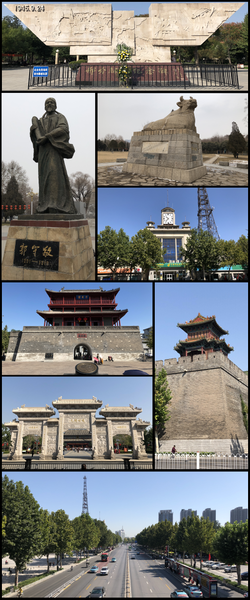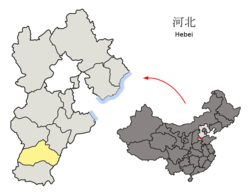Xingtai
Prefecture-level city in Hebei, People's Republic of China From Wikipedia, the free encyclopedia
Xingtai (simplified Chinese: 邢台; traditional Chinese: 邢臺; pinyin: Xíngtái; Wade–Giles: Hsing2-tʻai2), formerly known as Xingzhou and Shunde, is a prefecture-level city in southern Hebei province, People's Republic of China. It has a total area of 12,486 km2 (4,821 sq mi) and administers 4 districts, 2 county-level cities and 12 counties. At the 2020 census, its population was 7,111,106 inhabitants.[2] It borders Shijiazhuang and Hengshui in the north, Handan in the south, and the provinces of Shandong and Shanxi in the east and west respectively.
This article needs to be updated. The reason given is: As of June 23, 2020 The State Council have approved the renaming of Qiaoxi and Qiaodong districts, the full annexation of Xingtai County and the character-retaining annexation of Ren County (as Renze District) and Nanhe County (as Nanhe District). (June 2020) |
Xingtai
邢台市 Hsingtai, Shunteh | |
|---|---|
 Clockwise from top: Xingtai Liberation Monument, sculpture of Lying Bull, Xingtai Telegraph Building, city wall ruins and Huoshen Temple, Zhongxing West Street, Dakaiyuan Temple, Qingfeng Tower, statue of Guo Shoujing | |
| Nickname: Sitting Bull City (卧牛城) | |
 | |
 Location of Xingtai City jurisdiction in Hebei | |
| Coordinates (Xingtai municipal government): 37°04′18″N 114°30′17″E | |
| Country | People's Republic of China |
| Province | Hebei |
| Settled | 3500 BC |
| Established | November 15, 1983 |
| Area | |
| 12,432 km2 (4,800 sq mi) | |
| • Urban | 114.80 km2 (44.32 sq mi) |
| • Districts[1] | 132.3 km2 (51.1 sq mi) |
| Population (2020 census)[2] | |
| 7,111,106 | |
| • Density | 570/km2 (1,500/sq mi) |
| • Urban | 971,300 |
| • Urban density | 8,500/km2 (22,000/sq mi) |
| • Districts[1] | 971,000 |
| GDP[3] | |
| • Prefecture-level city | CN¥ 223.6 billion US$ 32.4 billion |
| • Per capita | CN¥ 24,256 US$3,894 |
| Time zone | UTC+8 (China Standard) |
| Postal code | 054000 |
| Area code | 0319 |
| ISO 3166 code | CN-HE-05 |
| Vehicle registration | 冀E |
| Website | www |
| Xingtai | |||||||||
|---|---|---|---|---|---|---|---|---|---|
| Simplified Chinese | 邢台 | ||||||||
| Traditional Chinese | 邢臺 | ||||||||
| Postal | Hsingtai | ||||||||
| Literal meaning | "temple of Xing" | ||||||||
| |||||||||
History
Summarize
Perspective
Xingtai is the oldest city in North China.[citation needed] The history of Xingtai can be traced back 3500 years ago. During the Shang dynasty, Xingtai functioned as a capital city. During the Zhou dynasty, the State of Xing – from which the present name derives – was founded in the city. During the Warring States period, the state of Zhao made Xingtai its provisional capital. The city was known as Xindu for most of the Qin dynasty, but after the 207 BC Battle of Julu (within present-day Pingxiang County, not today's Julu County), it became known as Xiangguo. During the Sixteen Kingdoms Period, when the Later Zhao was founded by Shi Le of the Jie, the capital was again at Xiangguo. During the Sui and Tang dynasties, the city was known as Xingzhou.
Sui, Tang and Song times saw the zenith of ceramics production in what was the most prolific ceramics center of northern China (rivaling the Yue ware from the South). The white ware and new technologies developed in the Xing kiln mark the transition from proto-porcelain to proper porcelain.[4] More than thirty kiln site have been excavated in different subdivisions of today's Xingtai City and a large high-tech museum have been established in Neiqiu County in 2017.[5][6][7]
During the Yuan dynasty, Ming, and Qing dynasties, Xingtai was called Shunde (Shundefu) and functioned as a prefecture in China.
Geography and climate
Summarize
Perspective
Xingtai has a continental, monsoon-influenced semi-arid climate (Köppen BSk).[8] It has hot, humid summers due to the East Asian monsoon, and generally cold, windy, very dry winters that reflect the influence of the vast Siberian anticyclone; fall is similar to spring both in temperature and lack of rainfall. In the spring, there are large sandstorms blowing in from the Mongolian steppe, accompanied by rapidly warming, but generally dry, conditions. The annual rainfall, more than half of which falls in July and August alone, is highly variable and not reliable. In the city itself, this amount has averaged to a mere 496.5 mm (19.5 in) per annum.
| Climate data for Xingtai, elevation 77 m (253 ft), (1991–2020 normals, extremes 1971–2010) | |||||||||||||
|---|---|---|---|---|---|---|---|---|---|---|---|---|---|
| Month | Jan | Feb | Mar | Apr | May | Jun | Jul | Aug | Sep | Oct | Nov | Dec | Year |
| Record high °C (°F) | 20.9 (69.6) |
27.4 (81.3) |
33.9 (93.0) |
36.5 (97.7) |
39.7 (103.5) |
42.4 (108.3) |
41.7 (107.1) |
38.7 (101.7) |
39.0 (102.2) |
37.0 (98.6) |
27.8 (82.0) |
27.6 (81.7) |
42.4 (108.3) |
| Mean daily maximum °C (°F) | 3.9 (39.0) |
8.2 (46.8) |
14.7 (58.5) |
21.9 (71.4) |
27.6 (81.7) |
32.3 (90.1) |
32.4 (90.3) |
30.7 (87.3) |
26.8 (80.2) |
21.2 (70.2) |
12.4 (54.3) |
5.5 (41.9) |
19.8 (67.6) |
| Daily mean °C (°F) | −0.7 (30.7) |
3.0 (37.4) |
9.1 (48.4) |
16.2 (61.2) |
22.1 (71.8) |
26.6 (79.9) |
27.8 (82.0) |
26.2 (79.2) |
21.6 (70.9) |
15.5 (59.9) |
7.1 (44.8) |
0.9 (33.6) |
14.6 (58.3) |
| Mean daily minimum °C (°F) | −4.3 (24.3) |
−1.0 (30.2) |
4.4 (39.9) |
10.9 (51.6) |
16.7 (62.1) |
21.4 (70.5) |
23.7 (74.7) |
22.4 (72.3) |
17.3 (63.1) |
10.8 (51.4) |
3.0 (37.4) |
−2.5 (27.5) |
10.2 (50.4) |
| Record low °C (°F) | −20.2 (−4.4) |
−15.6 (3.9) |
−10.9 (12.4) |
−4.9 (23.2) |
5.0 (41.0) |
9.9 (49.8) |
15.7 (60.3) |
13.2 (55.8) |
5.6 (42.1) |
−1.7 (28.9) |
−9.2 (15.4) |
−17.4 (0.7) |
−20.2 (−4.4) |
| Average precipitation mm (inches) | 2.9 (0.11) |
6.4 (0.25) |
10.3 (0.41) |
22.0 (0.87) |
43.4 (1.71) |
50.1 (1.97) |
151.0 (5.94) |
117.5 (4.63) |
59.8 (2.35) |
23.1 (0.91) |
15.1 (0.59) |
3.9 (0.15) |
505.5 (19.89) |
| Average precipitation days (≥ 0.1 mm) | 1.9 | 3.0 | 2.9 | 5.0 | 6.5 | 8.5 | 11.6 | 9.7 | 7.5 | 5.1 | 4.0 | 2.5 | 68.2 |
| Average snowy days | 3.4 | 3.4 | 1.2 | 0.2 | 0 | 0 | 0 | 0 | 0 | 0 | 1.3 | 3.3 | 12.8 |
| Average relative humidity (%) | 52 | 50 | 47 | 51 | 53 | 55 | 71 | 74 | 68 | 61 | 61 | 57 | 58 |
| Mean monthly sunshine hours | 138.0 | 149.7 | 189.8 | 221.4 | 247.4 | 215.6 | 179.5 | 188.7 | 172 | 177.2 | 144.4 | 134.5 | 2,158.2 |
| Percentage possible sunshine | 45 | 49 | 51 | 56 | 56 | 49 | 41 | 45 | 47 | 52 | 48 | 45 | 49 |
| Source 1: China Meteorological Administration[9][10] | |||||||||||||
| Source 2: Weather China[11] | |||||||||||||
Air quality
According to a survey made by "Global voices China" in February 2013, 7 cities in Hebei including Xingtai, Shijiazhuang, Baoding, Handan, Langfang, Hengshui and Tangshan, were among China's 10 most polluted cities; Xingtai ranked 1st in the list and had the worst air quality.[12] In 2020, the improvement rates of Xingtai's comprehensive air quality index and PM2.5 average concentration ranked first in Hebei Province. The average annual concentration of PM2.5 has successfully withdrawn from the "top ten" in China.
Xingtai earthquake
A major earthquake, known as the Xingtai earthquake, with magnitude 6.8 on the Richter scale and epicenter in Longyao County occurred in the early morning of March 8, 1966. It was followed by 5 earthquakes above magnitude 6 on the Richter scale that lasted until March 29, 1966. The strongest of these quakes had a magnitude of 7.2 and took place in the southeastern part of Ningjin County on March 22. The earthquake damage included 8,064 dead, 38,000 injured and more than 5 million destroyed houses.[13]
Administrative divisions
Summarize
Perspective

| Map | ||||
|---|---|---|---|---|
| Name | Chinese | Pinyin | Population (2020) | Area (km2) |
| Xiangdu District | 信都区 | Xiāngdū Qū | 362,857 | 116 |
| Xindu District | 襄都区 | Xìndū Qū | 798,770 | 1941 |
| Renze District | 任泽区 | Rènzé Qū | 342,869 | 431 |
| Nanhe District | 南和区 | Nánhé Qū | 350,384 | 405 |
| Lincheng County | 临城县 | Línchéng Xiàn | 199,793 | 797 |
| Neiqiu County | 内丘县 | Nèiqiū Xiàn | 260,000 | 788 |
| Baixiang County | 柏乡县 | Bǎixiāng Xiàn | 168,761 | 268 |
| Longyao County | 隆尧县 | Lóngyáo Xiàn | 480,447 | 749 |
| Ningjin County | 宁晋县 | Níngjìn Xiàn | 745,389 | 1,032 |
| Julu County | 巨鹿县 | Jùlù Xiàn | 346,007 | 631 |
| Xinhe County | 新河县 | Xīnhé Xiàn | 134,095 | 366 |
| Guangzong County | 广宗县 | Guǎngzōng Xiàn | 280,603 | 504 |
| Pingxiang County | 平乡县 | Píngxiāng Xiàn | 323,675 | 406 |
| Wei County | 威县 | Wēi Xiàn | 496,230 | 994 |
| Qinghe County | 清河县 | Qīnghé Xiàn | 421,582 | 500 |
| Linxi County | 临西县 | Línxī Xiàn | 326,968 | 542 |
| Nangong City | 南宫市 | Nángōng Shì | 396,718 | 861 |
| Shahe City | 沙河市 | Shāhé Shì | 431,746 | 859 |
| Xingtai Economic Development Area | 邢台经济开发区 | Xíng Tái Jīng Jì Kāi Fā Qū | 182,585 | - |
| Xingdong New Area | 邢东新区 | Xíng Dōng Xīn Qū | 63,367 | - |
Xingtai Economic Development Area and Xingdong New Area belong to Xiangdu District.
- Xingtai County - defunct
Economy
Xingtai is the most important base for natural resources in North China, producing 20 million metric tonnes of coal annually. It also features the largest power plant in the southern part of this region of China, with an output of 2.06 GW.[14]
Transport
Located on the Beijing−Guangzhou, the Beijing−Kowloon, the Xingtai-Huanghua and Xingtai-Heshun Railways, as well as the Beijing−Shenzhen, Daqing-Guangzhou, Taihangshan, Xingtai-Hengshui, Qingdao−Yinchuan, and Dongying-Lvliang Expressways and Xingtai Dalian Airport. Xingtai is a transport hub connecting the Eastern, Northern, and Central China. Xingtai is also served by Xingtai Dalian Airport which opened on 18 July 2024.
Notable persons
- Ren Xuefeng
- Hebei Pangzai
- Wei Lijie
- Guo Shoujing
- Liu Bingzhong
- Song Jing
- Chai Rong
- Seng Yixing
See also
References
External links
Wikiwand - on
Seamless Wikipedia browsing. On steroids.




